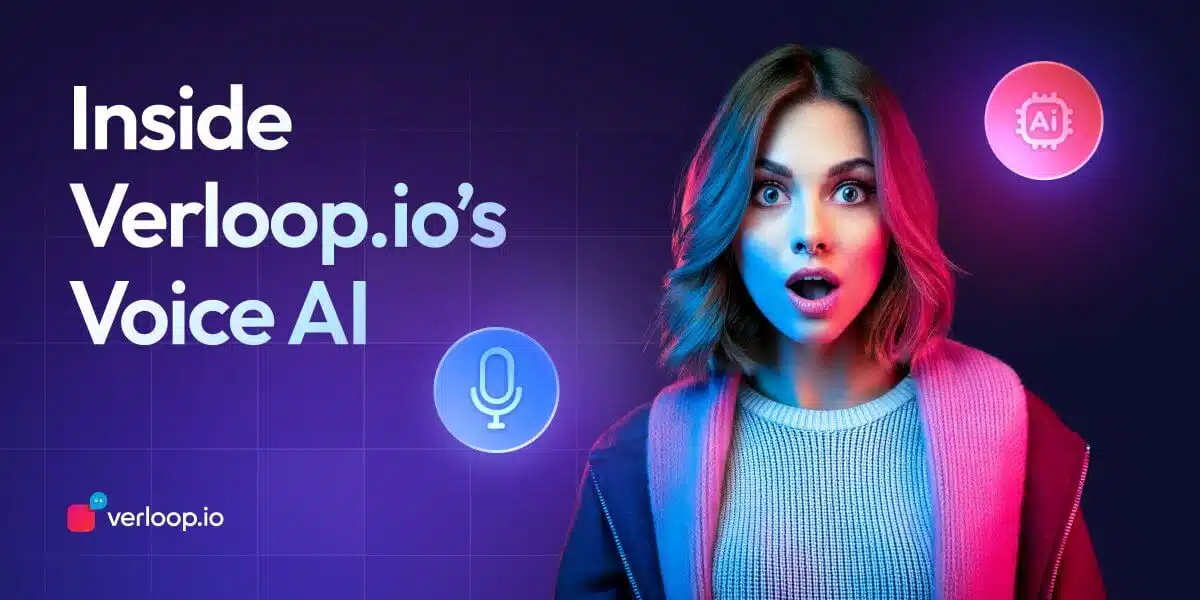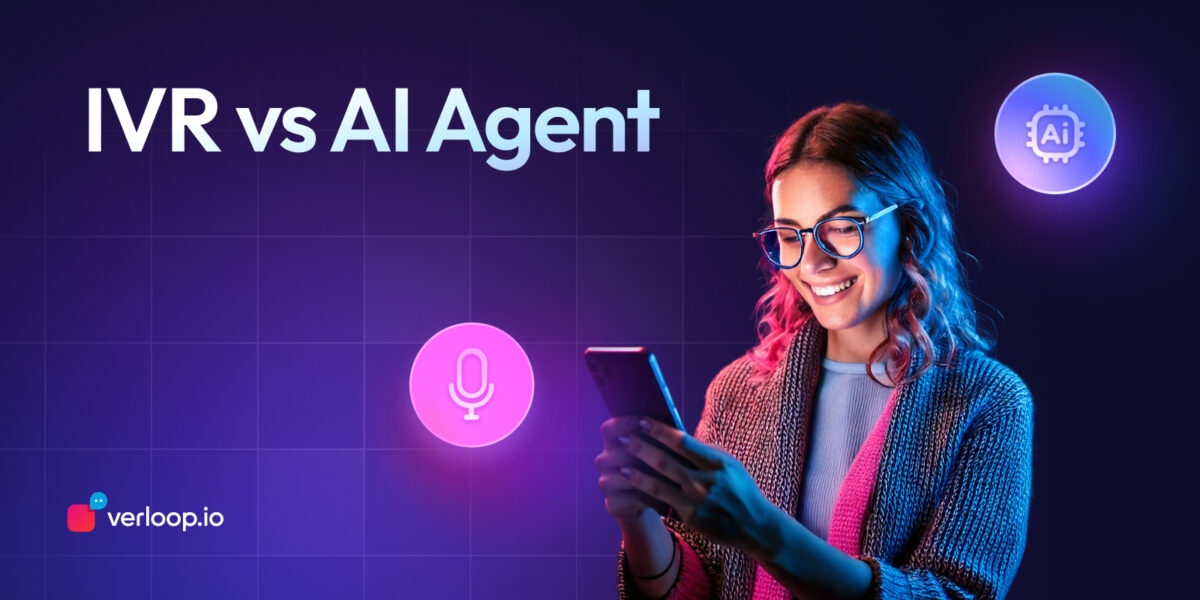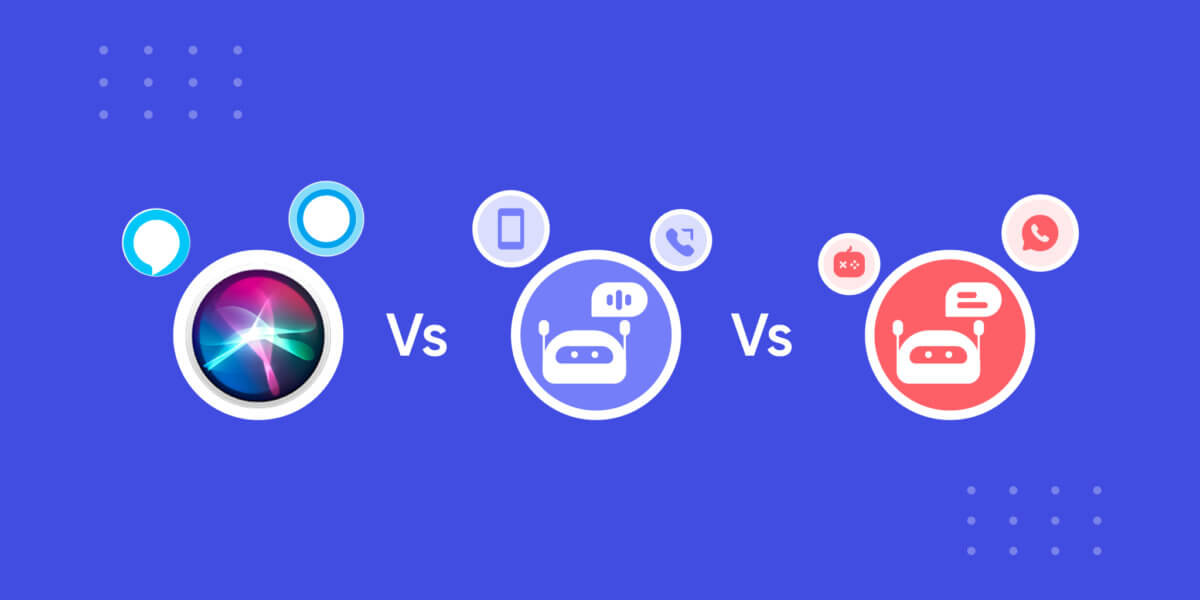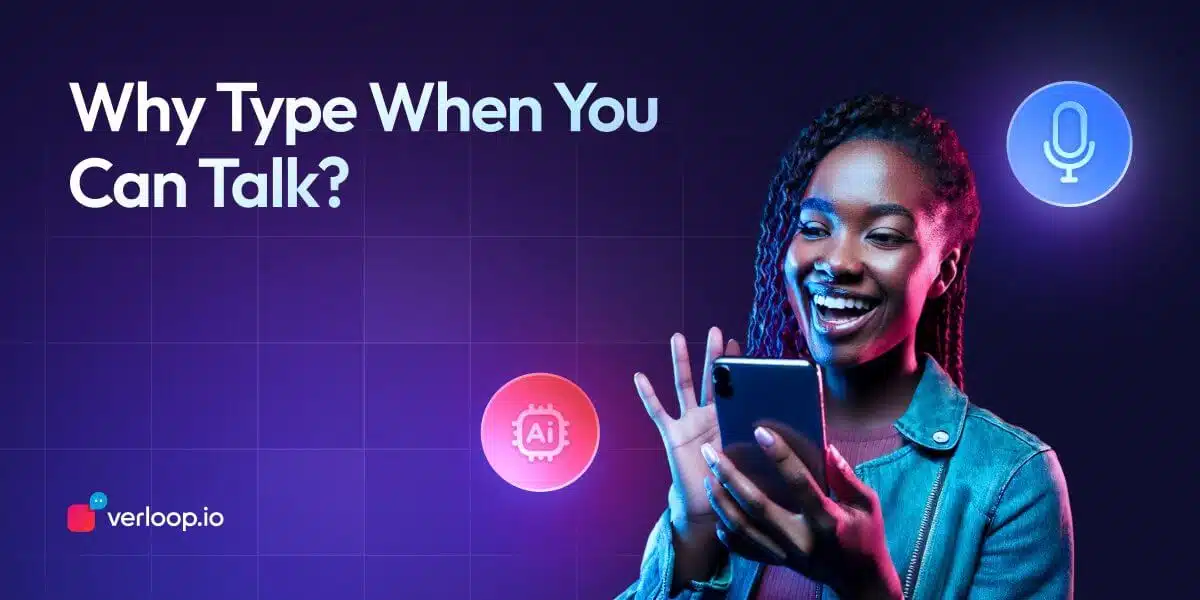
How Verloop.io’s Voice AI Works
- March 19th, 2025 / 5 Mins read
- Harshitha Raja
You call your bank to check a suspicious transaction.
A familiar cycle begins—endless hold music, an automated voice asking you to “Press 1 for balance, Press 2 for recent transactions,” and after navigating the maze, a long wait for an agent who asks for your details all over again.
Frustrating? Absolutely.
But now, imagine a different scenario.
You call, and instead of a clunky IVR, a voice—natural, conversational, and actually helpful—greets you:
“Hi, I see you’ve had a recent transaction from XYZ store for £200. If this wasn’t you, I can block your card and report it immediately. Would you like me to proceed?”
No menu. No waiting. No repeating yourself. Just instant, intelligent problem-solving.
This is the power of Voice AI, and it’s why the market is projected to hit USD 47.5 billion by 2034. Businesses aren’t just using AI for efficiency—they’re using it to build smoother, more human-like customer experiences at scale.
So, how does this technology actually work? And why are companies choosing Verloop.io’s Voice AI to power their customer conversations? Let’s break it down.
Voice AI Technology in 2025
Voice AI technology in 2025 is remarkably advanced and human-like.
What started as basic speech recognition systems has transformed into nuanced, context-aware dialogue engines. Today’s Voice AI can understand natural language, interpret user intent, and respond with speech that sounds nearly human.
It’s not just about recognising words – it’s about understanding meaning and context. Modern Voice AI can even handle multiple languages and accents, and detect the user’s tone or sentiment to some extent.
For example, LLM powered voice agents are learning to pick up emotional cues like frustration or excitement from a caller’s voice, and adapt their responses accordingly, making conversations feel more empathetic.
Crucially, these systems leverage deep learning and large language models in the backend. This means a AI voice assistant isn’t limited to scripted answers – it can generate appropriate responses on the fly, drawing from vast training data to sound natural and informative.
The result?
Speaking to an advanced voice AI system can feel as natural as speaking to a person. In fact, the AI’s voice can be indistinguishable from human voices.
How Voice AI Technology Works (The Basics)
Behind every seemingly effortless voice conversation with AI, there’s a complex chain of technologies working in harmony.
In simple terms, a Voice AI system converts your speech to text, understands what you mean, decides on the best response, and then speaks that response back to you. This entire process happens in seconds, creating the illusion of a real-time human conversation.
Here’s a breakdown of the typical Voice AI workflow with modern advancements:
Capturing and Recognising Speech:
It all starts when a customer speaks. Automatic Speech Recognition (ASR) transcribes speech into text using deep learning. It recognises accents, filters background noise, and understands fast-paced or varied speech with high accuracy.
Understanding the Intent
Once transcribed, Natural Language Processing (NLP) analyses the text to grasp intent and sentiment. Voice AI doesn’t just pick up keywords—it understands context, emotions, and urgency, enabling it to prioritise responses effectively.
Learning from Every Interaction with LLMs
What makes modern Voice AI truly intelligent is its ability to learn from vast amounts of data using Large Language Models (LLMs). These advanced AI models are trained on billions of conversations, allowing them to predict the best possible response even when users phrase things differently or ask complex questions.
Making Smarter Decisions with Machine Learning
Machine learning (ML) algorithms continuously improve Voice AI performance by analysing real-world interactions. Every conversation helps refine the system—teaching it new phrases, better speech recognition, and even more accurate intent detection.
Dialogue Management
This is the AI’s brain. It decides the next best action based on the conversation flow. Whether answering a question, retrieving information, or escalating a call, the system ensures seamless conversations—even remembering past details for continuity.
Natural Language Generation
AI-generated responses need to sound natural. With advanced NLG, voice AI ensures replies are fluid and human-like. Whether providing account details or assisting with a complaint, the AI crafts responses that feel intuitive and engaging.
Text to a Human-Like Voice
TTS(Text-to-Speech) technology converts AI-generated responses into realistic speech. Voice AI incorporates speech normalisation, ensuring dates, numbers, and structured data are spoken in a way that sounds natural, not robotic.
With these components working together, Voice AI enables real-time, intelligent conversations that feel human.
Read more about How voice AI works here.
Why Voice AI is Essential in 2025
In 2025, Voice AI technology isn’t a luxury – it’s a necessity for businesses aiming to deliver top-notch customer experience and keep up with the competition. The reasons for this are rooted in both customer expectations and operational efficiency.
First, customer behaviour has changed. Today’s consumers are comfortable talking to Alexa, Siri, and Google Assistant in their daily lives; naturally, they now expect the same instant, voice-driven convenience when they contact a business. In fact, voice interactions are becoming so common that there will be 8.4 billion voice assistants in use by 2024 – more voice bots than people on the planet.
For businesses, Voice AI offers game-changing advantages in automation and scalability. A single voice AI agent can handle thousands of calls simultaneously, something human teams could never do. Companies are using Voice AI to scale support without increasing costs.
Customer experience is another driving factor. Voice AI can significantly cut down wait times to less than a minute – no more being stuck in a queue listening to hold music. Customers get immediate answers or actions through an automated voice agent.
In many industries, adopting Voice AI is also about staying competitive. If one bank lets you check your account or report a lost card via a quick voice bot call at any hour, while another bank makes you wait until morning for an agent, it’s clear which offers a better experience.
Companies that fail to invest in AI-driven voice technology today will soon struggle to compete in a world where spoken interactions are the new standard.
So, how do you implement voice automation effectively? That’s where Verloop.io’s Voice AI comes into play – offering a state-of-the-art solution that makes deploying voice bots easier than ever.
Suggested Read : 5 Reasons to Prioritise Voice AI Assistants
Verloop.io’s Voice AI Explained
Building a capable voice bot from scratch can be daunting – but Verloop.io’s Voice AI platform simplifies the entire process. It provides businesses with a ready-to-use, comprehensive voice AI solution that combines advanced technology with user-friendly design.
Let’s break down how Verloop.io’s Voice AI works and the standout features that make it a go-to choice:
Bot Builder for Call Automation Flows
At the heart of Verloop.io’s Voice AI is an intuitive Bot Builder. This is a visual, self-serve interface where you design the conversation flow for your AI agent.
Verloop.io’s Bot Builder is a set of resources for creating automated conversational workflows (known as “recipes” in the platform). You can think of a recipe as the script or decision tree that the voice bot follows during a call. The platform supports different recipe options for AI chat conversations and AI voice calls to ease the bot building process.
In practice, that means you can craft a specialised call flow tailored to voice interactions – complete with the nuances voice requires – without any coding.
For instance, you can define how the bot should greet the caller, what information to collect (through voice prompts like “Please tell me your order ID”), how to handle pauses or unclear answers, and when to transfer to a human agent.
The Bot Builder provides building blocks that you simply drag-and-drop to create the call sequence. It even allows testing the call flow as you build, so you can preview the caller’s journey and fine-tune the experience before going live.
This level of control and ease empowers your team to set up voice bots quickly and refine them on the fly – without needing developers for every change.
Customising Your AI’s Voice to Match Your Brand
Every brand has a unique voice, and Verloop.io’s Voice AI lets you reflect that in your AI agent.
In the Settings of the Voice AI platform, you can choose speech profiles that define the voice AI agent’s voice and tone. In simple terms, this feature lets you select what your bot sounds like – perhaps a warm, friendly female voice for a hospitality business, or a confident, professional male voice for a banking service.
Moreover, Verloop.io will soon be introducing a Pronunciation tab to give you even finer control. This will allow businesses to guide the AI on how to pronounce specific words or names. It’s incredibly useful for brand names, product names, or industry jargon that the default text-to-speech might mispronounce.
This level of tweakability – from voice tone to pronunciation – means your Voice AI comes across as polished and professional, right out of the gate.
Plug-and-Play Deployment
One of the biggest challenges in rolling out a voice AI solution is integration with telephony systems. Verloop.io has solved this with a plug-and-play configuration that makes implementation remarkably easy.
The Voice AI Call Solution is designed to be easily deployable on your existing phone infrastructure – be it cloud telephony, IVR systems, ACD, or PBX.
In other words, you don’t have to rip out or heavily modify your current call centre technology; Verloop.io’s Voice AI will sit on top of it smoothly. It offers out-of-the-box connectors to popular Unified Communications platforms, so hooking the Voice AI into your workflow is often just a matter of a few settings.
Verloop.io’s plug-and-play approach significantly lowers the barrier to entry for voice automation. You get a fast, hassle-free deployment and can start realising benefits – like reduced call volumes and improved response times – almost immediately.
Real-Time Voice Analytics and Widgets
Once your Voice AI is handling calls, you’ll want to monitor its performance and gather insights.
Verloop.io makes this easy with real-time analytics widgets built into the platform. You get a live dashboard that displays key call metrics as they happen, so you always have a finger on the pulse of your voice support operations.
For instance, you can see hourly call traffic – how many calls the AI is handling each hour – which helps in understanding peak times.
There’s a widget for call disposition as well, which shows the outcome of each call (e.g., issue resolved, forwarded to human agent, caller hung up, no input, etc.). This real-time call disposition tracking is invaluable for supervisors to spot if, say, many calls are failing or being transferred, so they can intervene or adjust the bot’s recipe if needed.
Other statistics include overall call volumes, average call duration, and call direction distribution.
Additionally, to ease the entire analytics process, the dashboard also equips you with filters to apply to each widget. You can filter the data on the basis of phone numbers and call direction.
Essentially, Verloop.io provides actionable analytics at your fingertips, ensuring you’re never in the dark about what your voice bots are doing. This transparency helps in optimising the bot’s flows and improving service continually.
Detailed, Downloadable Reports
In addition to real-time dashboards, Verloop.io’s Voice AI platform offers downloadable reports for deeper analysis. You can generate comprehensive Voice AI reports that provide call-level insights over a selected period.
These reports offer call-level granular details like call start time, end time, duration, call status etc. helping teams refine strategies and enhance efficiency.
The reports provide a big-picture view of your Voice AI’s impact, as well as granular details for fine-tuning. They essentially answer the question, “how is our voice bot doing?” in quantifiable terms. Verloop.io makes this continuous improvement cycle straightforward by giving you the data you need, when you need it.
Take the Next Step with Voice AI
We’ve seen how advanced Voice AI systems work under the hood, and why so many companies are adopting them for faster, smarter customer service. The key is not just having Voice AI, but deploying it effectively.
Verloop.io’s Voice AI platform stands out by making this cutting-edge tech accessible and easy to use. It gives you the sophistication of a modern voice assistant with the simplicity of plug-and-play setup.
By choosing Verloop.io’s Voice AI, businesses can rapidly roll out voice automation that feels genuinely human and on-brand – all while saving costs and scaling up service quality. It’s a solution designed for the present and future of customer engagement, where speaking to an AI is as normal as sending an email.
If you’re looking to stay ahead of the curve and offer seamless voice interactions to your customers, now is the time to act. Give your brand a voice (literally) and let it converse with your users in real time. Verloop.io’s Voice AI makes it possible today.







